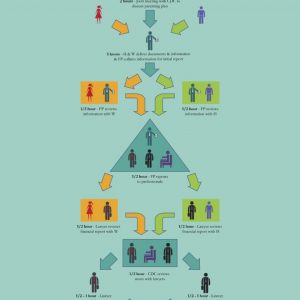I hear all the time that normal people can’t afford a collaborative divorce. Regular people who come to me for counsel on how best to restructure their families (of course, that’s not how they frame it up when they first walk through the door!) tell me this all the time.

But collaborative divorce is not just for the rich and famous. I teamed up with Shannon Green, a certified public accountant and collaborative financial neutral to prove that, to determine the average cost of a collaborative divorce in Florida. Luckily for us, the Florida Academy of Collaborative Professionals recently completed a study accumulating data from 101 collaborative matters completed in Florida between December 16, 2013 and January 31, 2018.
In our own study, Shannon and I first computed the average fee per hour charged by a total of 48 of the three types of professionals who work collaborative matters (attorneys, facilitators, and financial neutrals). Then we multiplied the average rate charged by each type of professional by the average hours spent by that professional across all 101 collaborative matters.
The two attorneys in every collaborative matter (one per spouse) together spend an average of 51 hours working these divorces. Their average hourly rate is $326, resulting in an average cost of $16,626 for the lawyers on any given matter. The facilitators average 29 hours, at an average hourly rate of $240, for a total of $6,960 per collaborative matter. Financial professionals average 54 hours per divorce, charging $211 per hour on average, for a total of $11,394 per matter.
The total cost for a collaborative divorce with a team that includes two attorneys, one facilitator, and one financial professional in Florida is, on average, $34,980. And that is the total cost for both spouses, less than $17,500 each. Obviously, as no one is really average, these numbers will vary for every divorce, depending on the hourly rates of the team professionals you choose and the number of hours they invest in restructuring your family.
While that might still seem high to you, consider that my 39 years of trial work demonstrate that a litigated divorce that goes to trial will cost each spouse, on average, $100,000 (or more). Litigated divorces are more expensive because, rather than working as a team, opposing counsels and parties battle it out in court, filing motions and creating expensive confrontations over every little issue. Instead of hiring neutral experts, litigating spouses each hire their own costly experts. The divorce is also controlled by the judge’s busy calendar, and a party who is situated better financially may choose to drag the divorce out as a strategy to get what he or she (thinks) he or she wants. The longer the divorce takes, the more costly it is.
By contrast, the collaborative team, professionals and clients, works together to complete the divorce as quickly and as painlessly as possible. The full team usually meets every three-to-four weeks for two-to-three hours, with separate working meetings of the clients with their lawyers, and/or with the neutrals, as needed, in between, until the matter is completely resolved. The momentum builds towards a peaceful finale rather than deteriorating into a litigation stagnation punctuated by periodic courtroom explosions and out-of-court flare-ups between spouses who have been pushed past their tolerances by the stress and costs of litigation.
Although every divorce is as unique as the family we restructure, the infographic pictured here depicts a typical collaborative divorce. Each spouse begins the process with as much as a two-hour initial consultation with his/her attorney, an hour consult with the team’s neutral financial professional, and an hour consult with their facilitator, a communication specialist with a mental health background. The lawyers will spend some time preparing and negotiating the collaborative participation agreement. All of the professionals then meet together for an hour or so without the spouses present to discuss the family, the issues, and other information gathered during the initial consultations.
Thereafter, the first full team meeting takes place. If they haven’t yet done it, this is when the spouses sign the participation agreement. They will then review their goals and interests, identified previously during their meetings with the facilitator, with the full team. This review takes place before every full team meeting, centering the clients and focusing them always on their ultimate, long-term objectives. Once all this is accomplished, they begin resolving the family’s issues, one by one.
With all team meetings, the professionals spend about a short time with each other and/or with the clients, bringing everyone up to speed beforehand, and debriefing afterwards.
Early in this process, the spouses also work with the facilitator, sometimes together and sometimes individually, depending on their needs, identifying their goals. If there are minor children, they will begin to negotiate the parenting plan. The spouses also gather financial information for the financial neutral, who then synthesizes and analyzes the information for his or her initial summaries, and, ultimately, the financial affidavits the child support guidelines worksheet, and the equitable distribution schedule. He then reviews and confirms the information with the spouses and provides his work to the other professionals. The lawyers also review his work with their clients.
Meanwhile, the facilitator reviews the parenting plan notes with the lawyers. If the facilitator has not already done so, one lawyer may prepare the parenting plan for the other’s review.
Sometime during this process, the second two-hour full team meeting will take place.
These steps are repeated, as necessary, until all issues have been addressed. Once a global resolution has been reached, one lawyer drafts the marital settlement agreement and other supporting documents, and the other attorney reviews the drafts. The final full team meeting, at which the spouses execute the documents, takes place. Although one attorney files everything, including a joint petition for divorce, if the clients wish it, the entire team may attend the final hearing with the spouses. (Most professionals do not bill their clients for this final appearance.)
Of course, there are less costly divorce options than the collaborative process. You may qualify for a default divorce if your spouse does not respond to your petition. If you don’t have difficult issues, like timesharing of minor children, you may be able to negotiate your divorce at your kitchen table and prepare your documents yourself. If you only have a few minor issues, you may be able to retain just one attorney who prepares the paperwork for you. Or, your spouse may want his own attorney to negotiate a few minor issues or to review the agreement that your attorney drafted.
That being said, many divorces involve more complex issues and require more professional help. If you find yourself in this situation, consider the collaborative option. Not only does it typically cost far less than a litigated divorce, but you’ll walk away with your relationship with your ex peacefully restructured, rather than shattered by the pressures and nature of the courtroom process.
Trust me; most of our collaborative clients are normal, regular folks just like you. Don’t litigate; collaborate!






